From rocket-shooting Les Pauls to 'bananas' Superstrats: 10 iconic Kiss guitars that powered rock's most outrageous band
10 bonkers guitars that chart the history of the American hard-rock institution
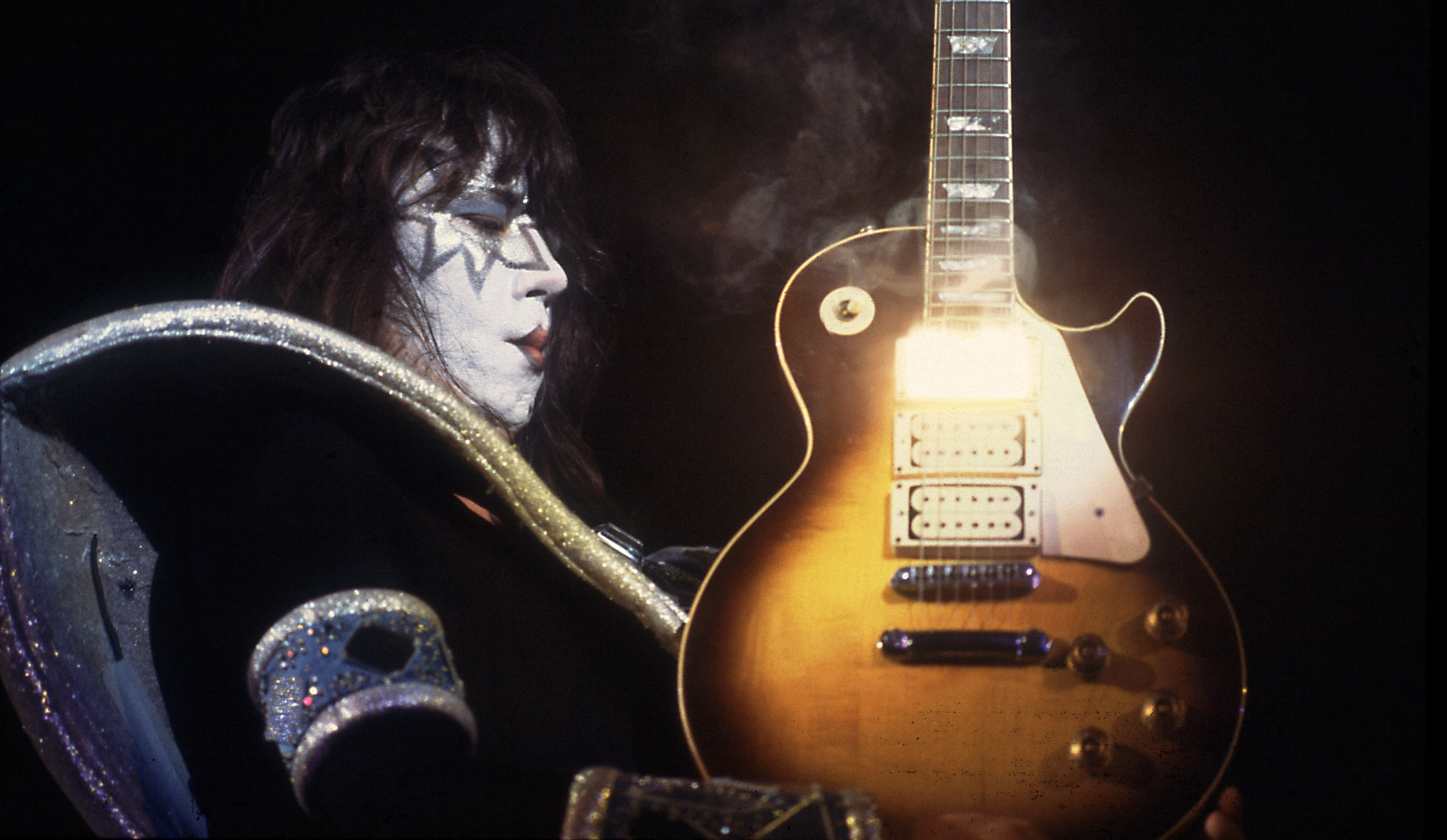
For a band like Kiss, it can't be easy upholding the moniker of 'The Hottest Band in the Land,' nor can it be easy to perpetually put on 'The Greatest Show on Earth.' Still, they've managed to do it.
Over the years, the various guitarists amongst Kiss's ranks – Ace Frehley, Paul Stanley, Bruce Kulick, Vinnie Vincent, and Tommy Thayer – have also evoked plenty of G.A.S. (Gear Acquisition Syndrome) through the use of some fantastic guitars.
Be it Frehley and Thayer's impressive cache of hare-brained Les Pauls, Stanley's bloodletting 'Cracked Mirror' PS-10, Kulick's presto 'Banana' M-1, or Vincent's Jackson Rhoads V, if you're a guitar aficionado, there's a lot to take in.
Through big chords, soaring solos, and a few bumps, bruises, and burns garnered along the way, Guitar World is taking a journey through just a few of the guitars that have defined Kiss over the years. Shield your eyes from the smoke, watch out for broken glass, and take cover from the rockets, and take in 10 landmark electric guitars that have defined Kiss's career.
1. Ace Frehley – 1973 Tobacco Sunburst Gibson Les Paul Deluxe
It's long been rumored that Frehley auditioned for Kiss with a late-'60s Gibson Firebird in nasty condition. Once he'd entered the Kiss fold, he reportedly recorded all of Kiss's debut record with an Ovation Breadwinner. But no matter: by February 1974, the Spaceman had found a gorgeous 1973 Les Paul Deluxe – which sported a dashing Tobacco Sunburst finish – at Manny's Music in New York City.
Frehley's first single-cut was fitted with mini-humbuckers when he purchased it. Seeking the classic '59 sound, however, Frehley quickly swapped them with a combination of full-sized DiMarzio Super Distortion/Dual Sound pickups. The '73 Les Paul was also fitted with Kluson double-bar tuners, a pancake body composed of four-ply maple and mahogany, and a three-piece maple neck with a rosewood fingerboard laid over it.
At some point, Frehley contoured the heel with a screwdriver, making it more comfortable for him until he all but retired the guitar in 1976. It's unknown if Frehley continued to record with the guitar thereafter, but considering what ultimately became of it, we'd wager it's rather unlikely.
Get The Pick Newsletter
All the latest guitar news, interviews, lessons, reviews, deals and more, direct to your inbox!
2. 1976 Cherry Sunburst Gibson Les Paul Custom, aka "The Budokan Guitar"
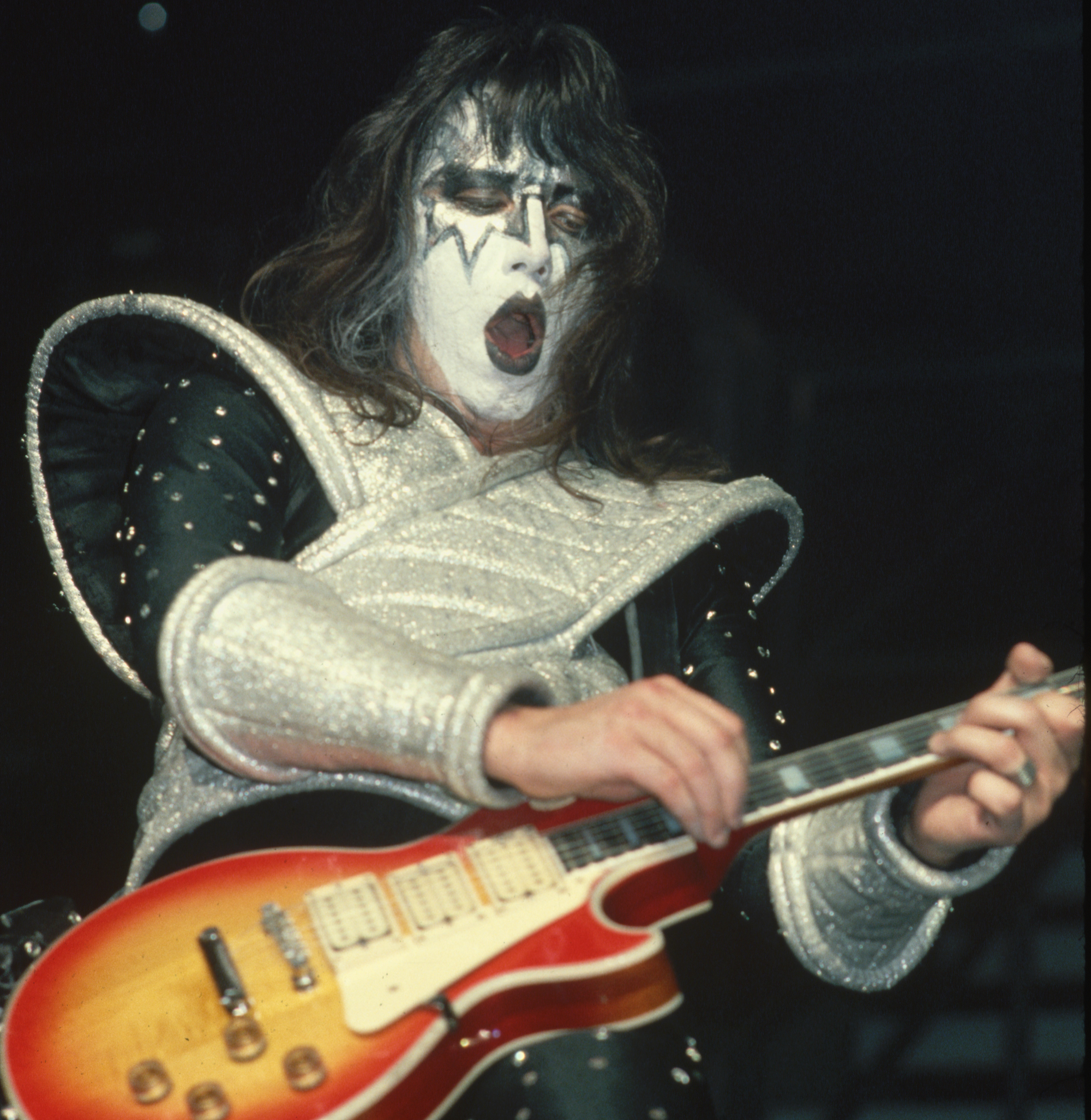
While it's been rumored that Frehley's '73 Deluxe had been stolen, the truth is that he painted the guitar black on a whim, didn't like it, and then turned it into a double-cut. The result was that it was time for a new guitar. And so, back to Manny's Music Frehley went, this time nabbing a '76 Les Paul Custom off the wall. When Frehley first purchased the guitar, it featured a distinctive two-pickup look, but Frehley quickly added a 'dead' middle pickup, simply because he liked the look of it.
Once again, the stock humbuckers were discarded, with Frehley opting for DiMarzio Super Distortion pickups, as he felt they gave him a 'hotter sound'. Now brandishing the guitar that would become synonymous with the Kiss sound and aesthetic, Frehley hit the road for some of the largest shows of Kiss's career, sporting the guitar during performances in Japan (where it was dubbed his 'Budokan guitar'), Europe, and the U.S.
Interestingly, Frehley is said to have often used Stratocasters on Kiss records and even fed his Gibson into Fender guitar amps hidden under the stage while on tour. This would have left those poor stacks of 100W Marshall amps idle and very lonesome if true.
Frehley would use guitars modeled after his '76 Les Paul well into Kiss's reunion era and through to today. These days, for his signature guitar, Frehley has his kabuki-clad mug adorning the headstock, a stopbar tailpiece, Grover tuners, and a gorgeous, flamed maple top.
3. 1977 Black Gibson Les Paul Custom, aka "The Smoker"
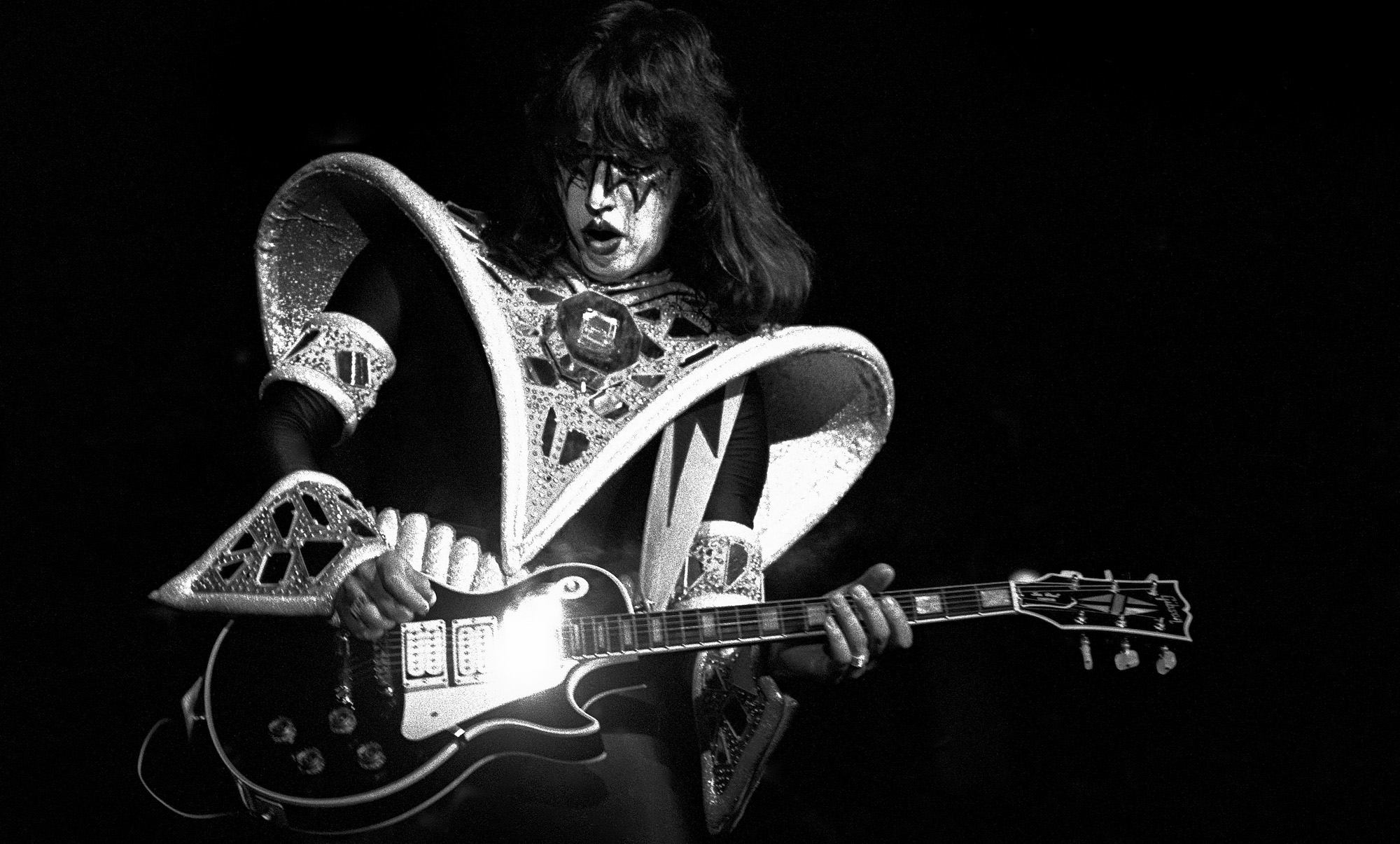
Frehley first developed the idea for what became known as 'The Smoker' in 1976 and reportedly used a Black '76 Les Paul Custom. Ever the mad scientist, Frehley is said to have modified the guitar himself.
While the guitar initially acted as intended, soon enough, the homemade electronics proved faulty. The Spaceman gave it a second go in '77, using yet another Black Les Paul Custom. This time, the guitar and its hot-wired innards held up, seeing that the '77 version stuck around through the '70s and into the early '80s.
Sure, it might have technically worked, but that didn't mean 'The Smoker' was remotely safe. To keep himself from being burned by the gobs of smoke spewing from the guitar's middle dummy pickup during his Shock Me guitar solo, Frehley installed a cardboard shield. It's worth noting that Frehley's smoking guitar returned during the reunion era, along with another insane guitar – a '57 Gibson Black Beauty, which shot rockets. We'll get to that one later...
4. Late '50s Gibson TV Les Paul, aka "The New York Groove Guitar"
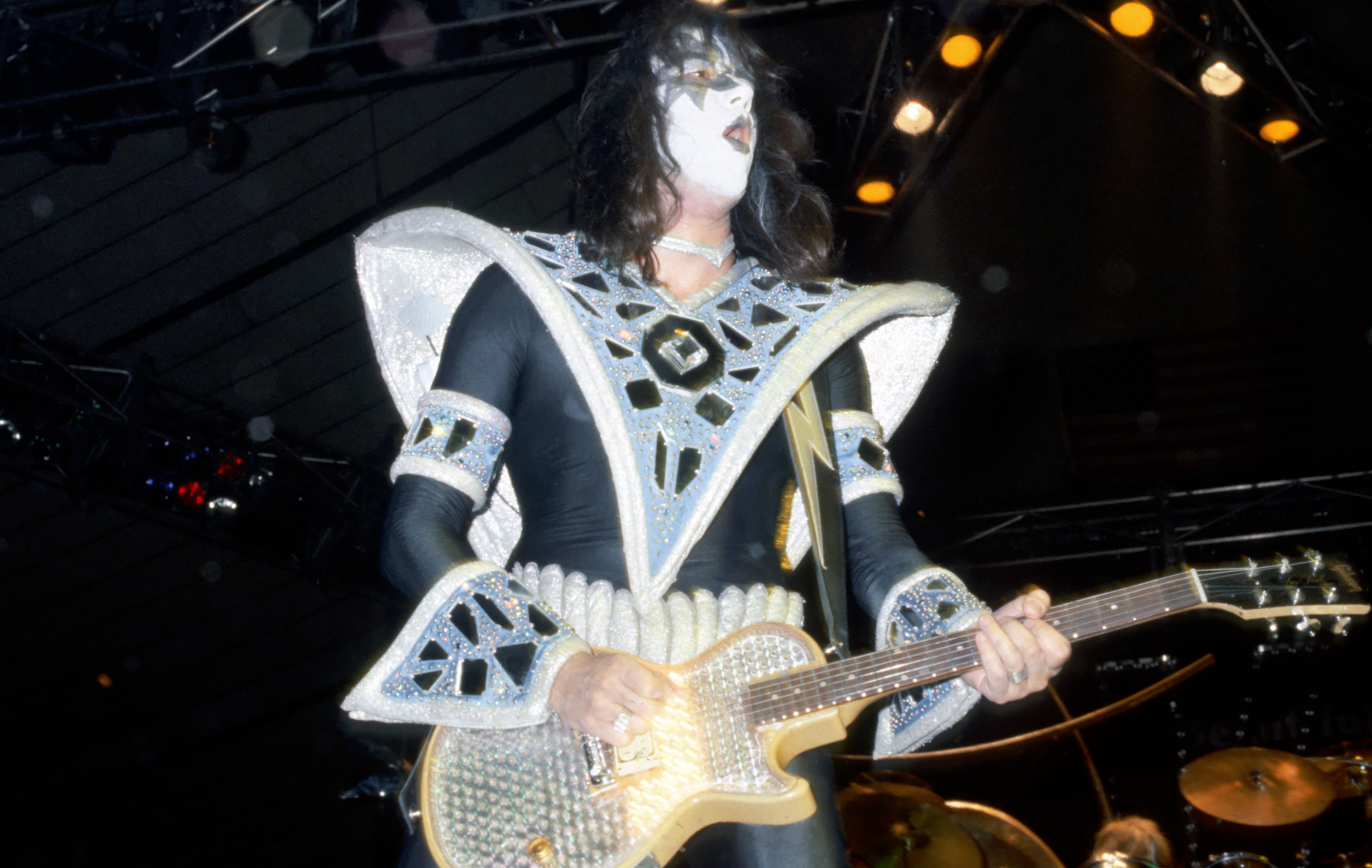
As far as we can tell, the exact year of Ace Frehley's infamous New York Groove light-up guitar is unknown. But we do know that Frehley took what would now be considered a sacred guitar – a late '50s TV Les Paul – and had the face routed to hold upwards of 1,000 incandescent lights.
Of course, this was an era before the advent of LEDs, so Frehley instead went with bulbs powered by a Ni-Clad battery pack, leading to a mostly reliable unit.
The guitar was the brainchild of Frehley, but instead of doing it himself, this time, he solicited the services of Milton Bradley toy designer John Elder Robison. The guitar first surfaced in 1979 while on the Dynasty tour and was exclusively used by Frehley when playing New York Groove, which featured on his 1978 self-titled solo record.
While generally reliable, the guitar wasn't always user-friendly, and the old-school lights often became red-hot, leading to burns. These days, Frehley still deploys an updated version of the guitar, now decked out with LEDs powered by an RC battery. It's also worth noting that John 5 – ever the Frehley fan – created his own version: with a Telecaster, of course.
5. 1957 Les Paul Black Beauty, aka "The Rocket Shooting Guitar"

It's a bit cringeworthy to think that a '57 Black Beauty was ultimately used in this way, but far be it from us to challenge the wisdom of one of rock music's most eccentric characters. Anyway, in Frehley's early rocket-shooting days, he would shoot bottle rockets from his headstock while tufts of smoke spewed from "The Smoker".
Eventually, that wasn't enough, leading him to push the proverbial envelope further. The most famous of his rocket-shooting Les Paul guitars would be this '57 Black Beauty.
Not that sound or accoutrements mattered much in this instance, but dig into the specs we shall – the Black Beauty "Rocket Shooting Guitar" featured classic Grover kidney-bean tuners, and Frehley's typical dummy middle pickup, surrounded by DiMarzio Super Distortions. This time, though, Frehley had Steve Carr design a double-barreled contraption that shot rockets at the ceiling of whatever venue he was playing at. Wild and crazy, indeed.
6. Paul Stanley – 1977 Black Ibanez PS-10
First and foremost, it's essential to get the facts straight on Stanley's Ibanez. Many often mistake the Starchild's guitar for an Iceman, but it's not. While the Iceman had existed in various forms before Stanley's PS-10, later versions of the Iceman came about as a means for Ibanez to copy Stanley's guitar en masse without paying the rocker a royalty. If you were to ask Stanley about it, or make the mistake in his presence, be forewarned; he shall bristle and assertively correct you.
The PS-10 came about after Kiss's tour around Japan in '76 exposed Stanley to multitudes of guitar shapes he'd never seen before. Upon returning home, he knew he wanted to craft a guitar bearing his signature. But as a disciple of Les Pauls, he also wanted the guitar to maintain the feel of those sacred talismans if he were 'to close his eyes'.
So, after a meeting with Ibanez in late '76, in 1977, the PS-10 was born. Sure, it looks nothing like a Les Paul, and it's debatable if its neck or weight distribution are similar, either.
Nevertheless, Stanley nailed the LP Deluxe sound, which is unsurprising considering the PS-10 features two chrome-plated mini-humbuckers. Beyond that, the PS-10 is made of mahogany, which Stanley finds to be the 'ultimate tonewood', and features a 14" radius neck, jumbo frets, and a very Les Paul-like set up of two-tone knobs and two volume knobs.
While it might not look like a Les Paul – or feel like one, despite Stanley's intention – the heart and soul is there. Moreover, there's no denying that the PS-10 is a hallmark of the Kiss visual experience to this day.
7. 1977 Ibanez PS-10 CM, aka "The Cracked Mirror Guitar"
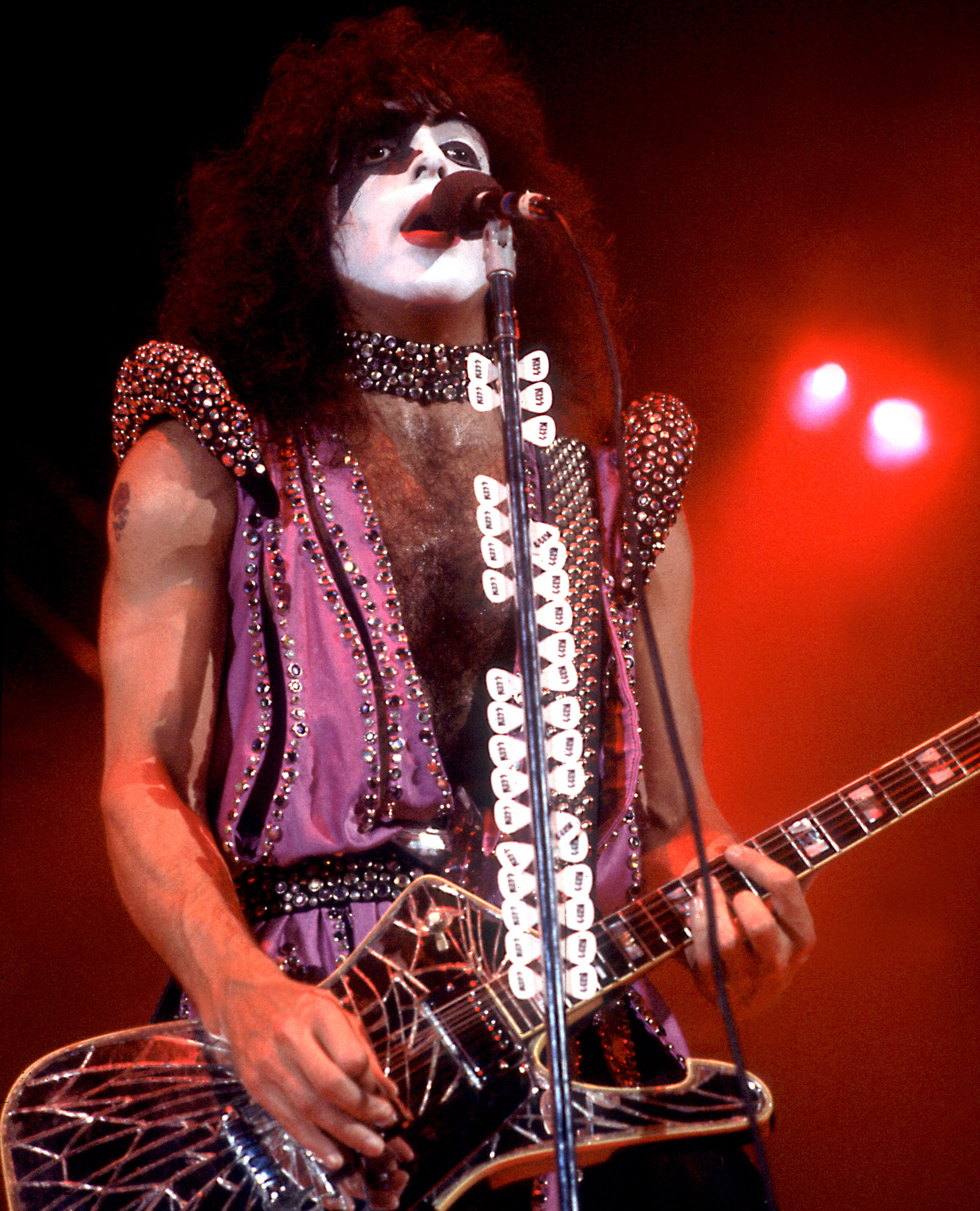
Stanley was fitted out with his PS-10 model before Kiss hopped on tour to support Love Gun. The guitar traveled the world with him, instantly replacing most of his previously used Gibson Firebirds and Explorers (though Stanley, as he does to this day, broke out his Gibson Flying V during Black Diamond). The PS-10 was sleek, to be sure, and its prominent 'wall of sound' vibe aided in the creation of Alive II and his self-titled 1978 solo record.
By 1979, though, preparations for Kiss's Dynasty tour were underway, as were discussions for the updated costumes and stage show Kiss would deploy. Stanley felt that he needed to update the PS-10 to fit into the disco theme Kiss was adopting, so the PS-10 CM was born.
Of course, the CM stands for 'Cracked Mirror,' which came about due to Stanley asking Ibanez to shatter a mirror and glue the pieces to the top of a PS-10. At first, Ibanez thought Stanley was crazy, but the company did it anyway. The result was a gorgeous guitar that Stanley still uses to this day.
The PS-10 CM is identical to a standard black PS-10 in terms of specs, with the biggest difference being its weight. With oodles of glass glued to its face, the PS-10 CM was heavy, leading to many sleepless nights due to a sore shoulder. Moreover, playing the guitar was dangerous for Stanley, considering the shards of broken glass would often slice Stanley's hands.
The guitar's most infamous moment, however, came early in the Dynasty tour, when Stanley – who had forgotten the guitar was covered in shards of glass – smashed his PS-10 CM at the end of Rock and Roll All Nite, leaving glass all over the stage, and Ace Frehley cackling with laughter.
8. Bruce Kulick – 1987 Yellow ESP M-1 Custom, aka "The Banana Guitar"
Like all of Kiss's six-stringers, Bruce Kulick has played a ton of lively guitars over the years. But he's primarily associated with ESPs, and if we dial back to the late-'80s and early '90s – smack in the middle of Kulick's time with Kiss – you'd find that, among the many guitars he used, his ESP M-1 Superstrat stood out more than most.
When he first joined Kiss in '84 during the Animalize tour, and then during the Asylum era in '85, Kulick often used his 'Flip Flop Blue' M-1. Kulick loved the guitar so much that it became his primary guitar, leading to many trips to the ESP factory, where he eventually created several custom M-1 guitars.
The most infamous of these is 'The Banana' guitar, which was lovingly nicknamed by Kiss's roadcrew in reference to its bright yellow finish. Those involved were so committed to the name that the roadcrew adhered a Chiquita sticker to the M-1s body, just under the strings. Kulick loved it, and to this day, the sticker remains.
In retrospect, it's not hard to see why Kulick loved the M-1, as it sounded as good as it looked. The M-1's rosewood fingerboard and sleek neck made the guitar uber-playable. Also sporting a Seymour Duncan pickup, Floyd Rose tremolo, and simple, two-knob control setup, the guitar was a staple of Kulick's recording and live career with Kiss.
Along with his red B.C. Rich 'Radioactive' curio, Kulick used his custom ESP M-1 extensively during the late-'80s Crazy Nights era and well into the '90s. Its status as a legendary Superstrat, playability, and sweet-sounding tones are just a few reasons why Kulick's 'Banana' ESP is one of the most beloved Kiss-related guitars.
9. Vinnie Vincent – 1981 Jackson Rhoads V
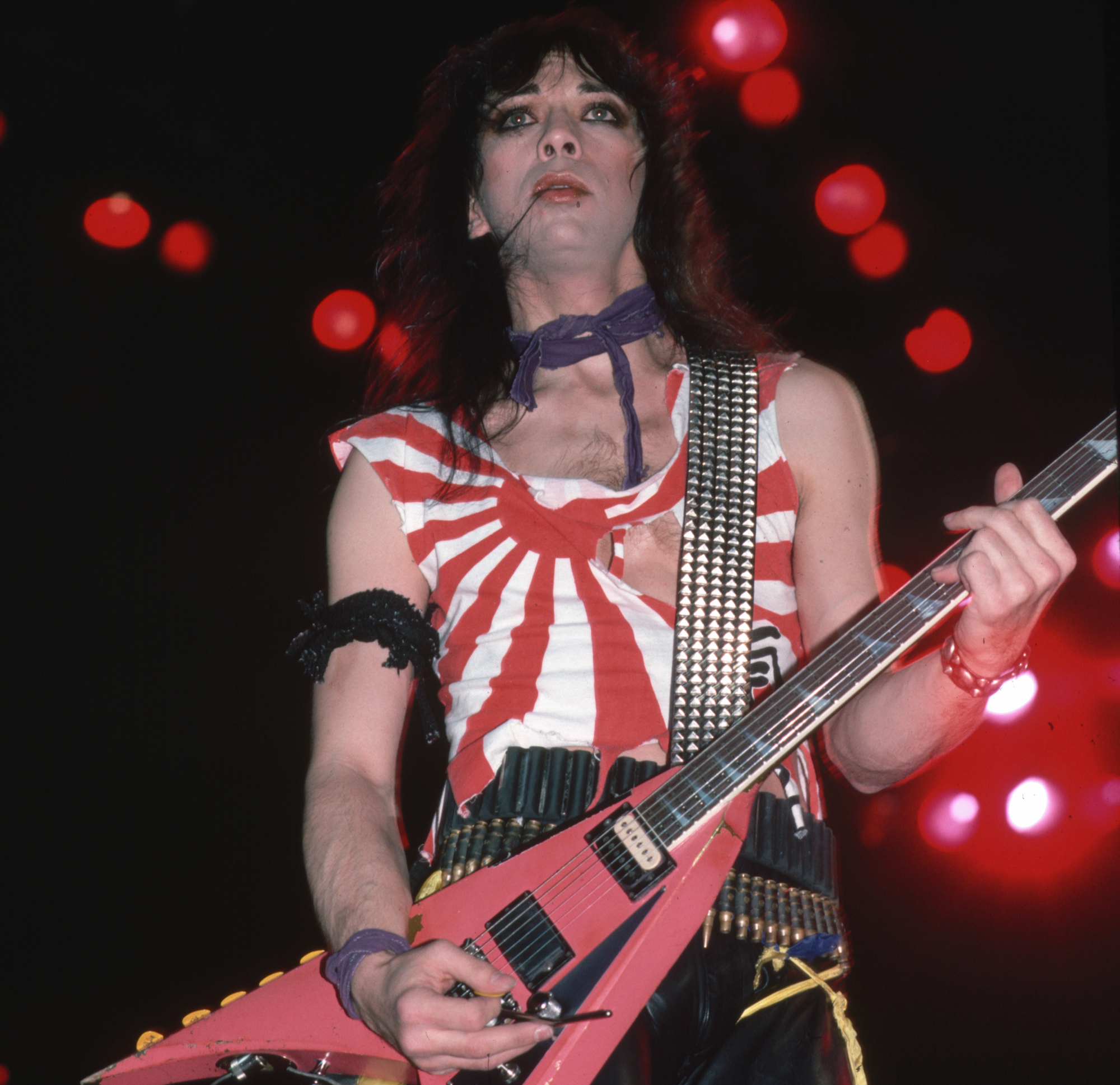
Vinnie Vincent is probably more well-known for his antics within Kiss than the guitars he used during his time in the band. Still, the 1981 Jackson Rhoads V Vincent used between 1982 and 1983 remains an iconic staple of his time with the rock icons.
Of course, Vincent – with his penchant for flash and bravado – had to have a guitar that would match his supposed virtuosity. Indeed, Vincent was never one to be upstaged – even as a newcomer – and so, a simple Strat or Les Paul would never do, much to the dismay of his bandmates.
To that end, the insertion of the V was odd within Kiss's ranks. The band had always preached the 'keep it simple, stupid' mantra and preferred decidedly classic-looking and sounding guitars.
Undeterred, Vincent moved to insert his V into the mix, a guitar he had been given by Jackson not long after Randy Rhoads' untimely death. For the uninitiated, the Rhoads V, with its asymmetrical design, maple neck and body, ebony fretboard, medium frets, Strat-style tremolo, and Seymour Duncan pickups, was designed by Jackson after being commissioned by Rhoads.
Soon after receiving the guitar, Vincent modified the V, adding a second V at a slight rotation to the first, mimicking a shadow.
While with Kiss, Vincent mostly used white-colored Vs, but after he was fired from the band, Jackson began production of about 25 of the Vincent-modified versions in bubblegum pink from 1985 through 1988. Finding one of those, however, is about as tricky as getting a hold of the reclusive Vincent himself.
10. Tommy Thayer – 2013 Signature Electric Blue Epiphone Les Paul
Tommy Thayer has long used Les Pauls, dating back to his days with Black 'N Blue in the '80s. When he first joined Kiss, that trend continued, with Thayer using various Gibson 'Burst models when touring with the band. It's no surprise, then, that when Thayer finally got together with the fine folks at Epiphone, he stuck with a classic single-cut, but added quite the twist.
Kiss have featured a great many guitars on stage over the years, all of which are decidedly unique. Thayer's signature Epiphone Les Pauls, however, stand out with their Electric Blue and White Lightning finishes. Thayer had a few models adorned with his namesake prior, sure, but the Electric Blue version of his signature guitar truly takes the cake.
The story goes that Kiss's drummer, Eric Singer, had turned Thayer on to the work of John Douglas, a custom painter. Douglas then worked with Thayer and Epiphone in 2013 to create the custom Electric Blue color.
As for specs, Thayer's signature models are usually equipped with Seymour Duncan humbuckers, medium jumbo frets, a Graph Tech nut, and an Indian laurel fingerboard with trapezoid inlays. Some snazzier features include a gorgeous chrome-finished pickguard, a Spaceman logo on the back of the headstock, and Thayer's signature engraved in the metal truss rod cover. All told, despite its budget nature, Thayer's Epiphone signature model is a sight to behold, indeed.
Andrew Daly is an iced-coffee-addicted, oddball Telecaster-playing, alfredo pasta-loving journalist from Long Island, NY, who, in addition to being a contributing writer for Guitar World, scribes for Bass Player, Guitar Player, Guitarist, and MusicRadar. Andrew has interviewed favorites like Ace Frehley, Johnny Marr, Vito Bratta, Bruce Kulick, Joe Perry, Brad Whitford, Tom Morello, Rich Robinson, and Paul Stanley, while his all-time favorite (rhythm player), Keith Richards, continues to elude him.
“It holds its own purely as a playable guitar. It’s really cool for the traveling musician – you can bring it on a flight and it fits beneath the seat”: Why Steve Stevens put his name to a foldable guitar
“Finely tuned instruments with effortless playability and one of the best vibratos there is”: PRS Standard 24 Satin and S2 Standard 24 Satin review










